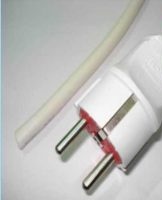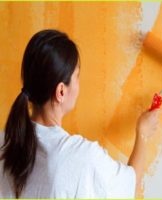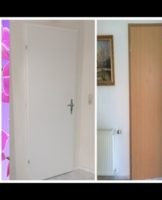How to paint lacquered furniture at home without removing the varnish
Who does not know how to paint old lacquered furniture without first removing the varnish may not even care. It turns out that chipboard or glossy laminated MDF just needs to be sanded and primed. Removing varnish from such furniture is not recommended. The main thing is to roughen the surface and paint or varnish the elements in a horizontal position.
Features of painting varnished surfaces
It is recommended to paint old furniture made of chipboard, MDF with a varnished surface without removing the varnish. The slabs from which cabinets, bedside tables and tables of the Soviet era and our time are made, are made of small shavings of wood glued together with glue. From above, this factory material is covered with textured paper and varnished. If the top layer is removed, the furniture board may crumble or warp. It is better not to remove the varnish, but just lightly sand it.
The main steps for painting lacquered furniture without removing the varnish:
- disassemble the cabinet into its component parts (separate doors, shelves);
- walk along the surface with fine-grain emery paper (sand the base), while it is important to create roughness without removing varnish;
- putty cracks, dents, scratches;
- wipe the surface (degrease) with acetone, solvent;
- apply a coat of primer;
- paint the furniture with a roller, brush or spray gun;
- it is better to paint the doors in a horizontal position;
- before painting in lighter colors, it is recommended to give the surface a white color;
- furniture is painted in 2-3 layers, be sure to observe the drying interval;
- after the paint is completely dry, the surface can be varnished.
You can only completely remove varnish from varnished furniture made from natural wood species. The top layer of varnish is removed using chemical agents for washing off the old coating or mechanically (with a scraper, sandpaper, grinder with abrasive nozzles). Before painting, the tree must be sanded (sanded with fine-grained sandpaper or a sander), putty on defects, degreased and primed.
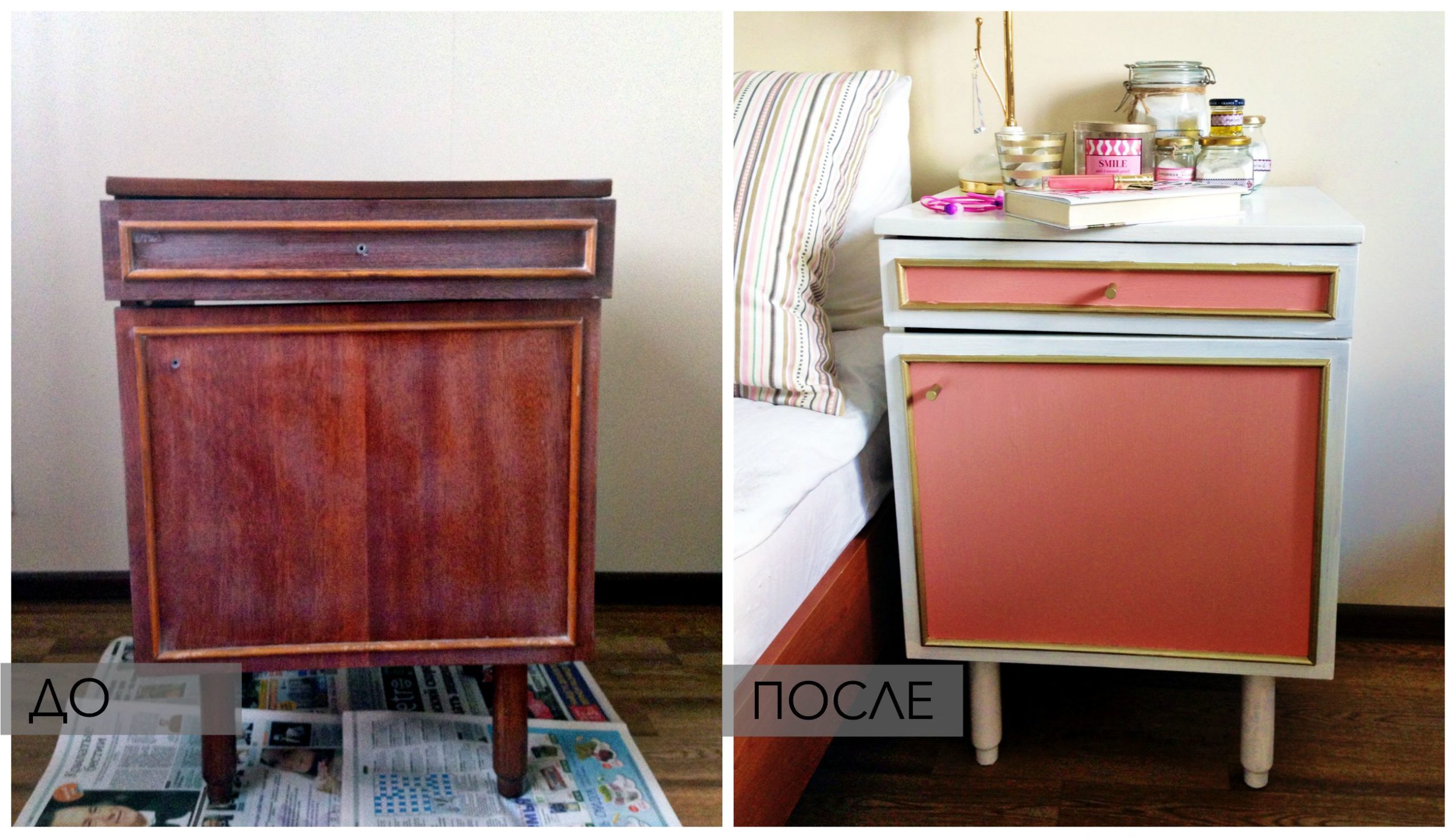
Adapted formulas
Acrylic and alkyd compounds are ideal for painting lacquered furniture. It is not recommended to paint interior items with oil, epoxy coatings. It is possible not to repaint the boards, but simply to renew them with a new coat of transparent varnish. As a rule, only the front of the piece of furniture is varnished.
Water-based acrylic paint
Acrylic aqueous dispersion is an ideal paint for painting and cardinally repainting old lacquered furniture in a room. These paints and varnishes can create a matte and semi-gloss finish. Acrylic dispersions can be tinted in different shades.The coating can have a uniform or textured appearance. There are paint materials for gold, bronze, silver. Sold in jars, plastic buckets or spray cans. Apply to the surface with a foam roller, a synthetic brush, a spray gun.

Advantages of acrylic dispersion:
- does not contain toxic substances;
- diluted with plain water;
- dries quickly;
- after drying, creates a film resistant to mechanical damage;
- the coating is moisture resistant and has a long lifespan.
Disadvantages:
- generally sold in white, you must order the stain before painting;
- hardens quickly, old stains can only be removed with a solvent.
Enamel or clear varnish
Painting lacquered furniture can be done with alkyd enamel (solvent). This paint material has a thick consistency. Enamel can be tinted in 1000 or more different shades. It is applied to the surface using a paint gun or a brush (roller).

Advantages of enamels:
- does not stain on a vertical surface;
- forms a matte or glossy finish;
- after drying, creates a solid, hard and moisture-resistant film on the surface.
Disadvantages:
- toxic composition, contains a solvent;
- high price.
After the paint dries, the surface can be varnished. As a rule, acrylic paint materials are used to varnish furniture painted with acrylics. After alkyd compositions, alkyd varnishes are used. Before using paint and varnish products, you should read the compatibility recommendations.
The varnish can be renewed with a nitrocellulose or polyurethane varnish. For the restoration of lacquered antique furniture, shellacs (schellak) are used, these compounds adhere to any surface, applied with a cotton swab.
Metallic paint
Lacquered furniture can be painted with metallic paint materials, for example, hammer paint (with embossing effect) based on alkyd resins or alkyd enamel, acrylic water dispersion for bronze, silver, gold .
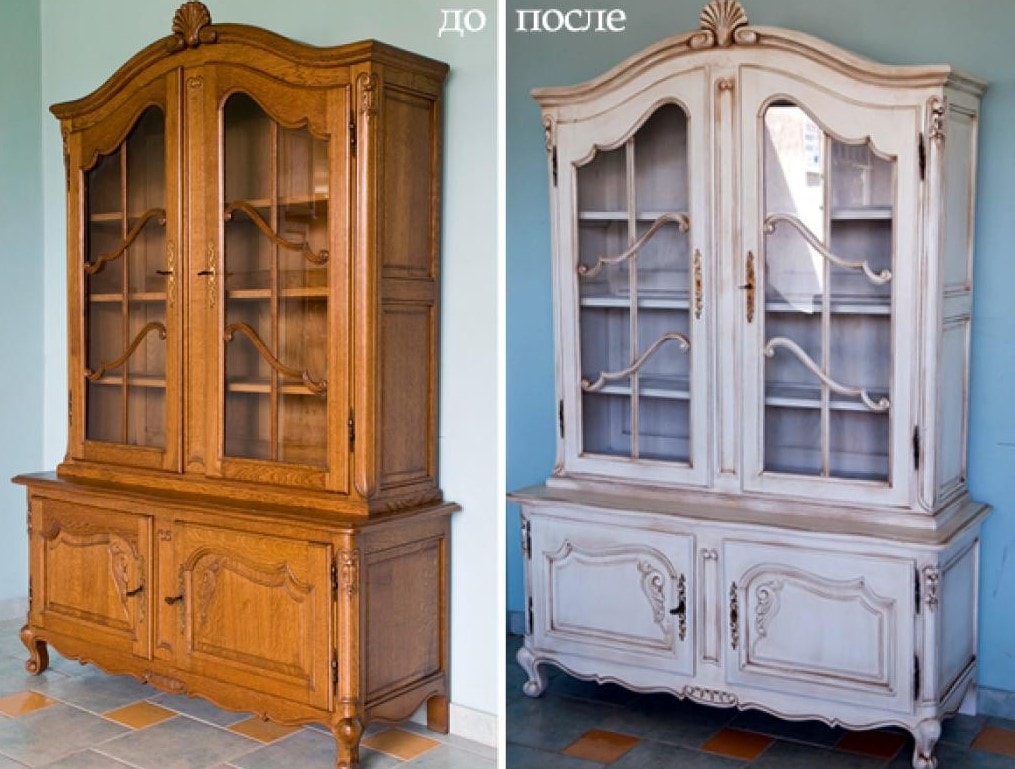
Advantages of using metallic effect paint materials:
- decorative appearance;
- ease of use (any kind of painting materials are applied to the prepared and primed surface);
- after drying, a strong, moisture-resistant film is formed.
Disadvantages:
- high price of paint materials;
- solvent-based paints are toxic.
Choice criteria
There are several options for restoring old lacquered furniture. It can be covered with solid paint and dramatically change its color and appearance. In this case, it is recommended to purchase an acrylic dispersion or an alkyd enamel of the desired shade. Once the paint has dried (after a month), the painted base can be varnished.
If you do not want to repaint lacquered furniture, you can simply renew the varnish. In order to give a glossy shine to the furniture blades, it is recommended to purchase a transparent varnish (polyurethane, shellac, alkyd, nitrocellulose).
Do-it-yourself painting without removing varnish
Restoration of lacquered furniture can be done by yourself. The main thing is to choose the right paint materials, prepare the base for painting, and never paint wet plates.

What is necessary
To paint, you need the following tools and materials:
- brushes with synthetic bristles for acrylic (2-3 pieces of different sizes);
- foam roller (for acrylic painting on water);
- roller on a fur coat with a short nap (for enamels with solvents);
- spray gun (for a smoother and more even application of paint materials);
- roller tray;
- masking tape to bond the surface and protect against painting;
- primer (for acrylic paints and varnishes - acrylic, for alkyd - alkyd);
- fine-grained sandpaper (3-4 pieces);
- acetone or white spirit for degreasing and stain removal;
- polyethylene oilcloth to protect the floor, furniture;
- sponges, rags;
- Screwdriver set.
Surface preparation
The main surface preparation steps:
- remove all objects and things from the surface for painting;
- dismantle the cabinet into its component parts (remove the doors);
- unscrew the handles;
- cover the floor of the apartment where the painting will be done with plastic wrap;
- sand the boards of the furniture with fine-grain emery paper, without removing the layer of varnish;
- create roughness for better paint adhesion;
- putty cracks and scratches;
- degrease the surface, wipe with acetone or solvent;
- using a roller or brush, go over the surface with a primer.
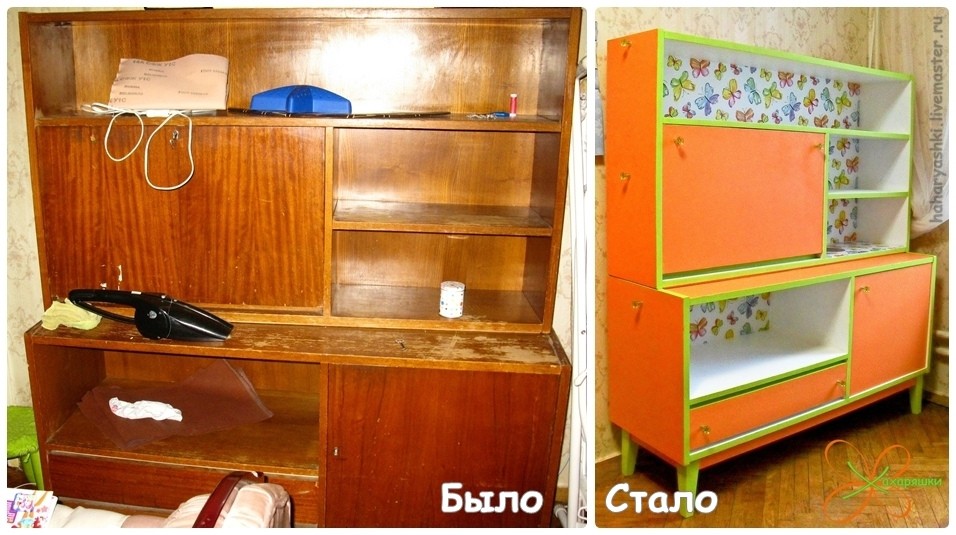
Coloring order
Rules for painting lacquered furniture:
- paint can be applied only on an absolutely dry basis;
- doors are best painted horizontally using a roller;
- it is recommended to paint the furniture in 2-3 layers;
- after applying each layer of paint, it is necessary to maintain the drying interval;
- Paint materials should be applied in a thin layer to avoid sags and smudges;
- it is better to do 2-3 thin layers than one thick;
- the paint should be applied in vertical or horizontal stripes.
Drying
Painted furniture should dry naturally (outside). Wait 6 to 12 hours before applying a new coat of paint.In the instructions or on the label, each manufacturer of paint materials indicates the intercoat drying interval.
Solve common problems
When painting lacquered furniture, unforeseen difficulties may arise. All problems can be solved, but it is advisable not to make mistakes.
Nuances to which it is recommended to pay attention when painting:
- too liquid paint can flow from a vertical smooth surface (it is better to sand or prime the plate and place it vertically);
- gluing is possible if you do not dry the paint and close the newly painted doors;
- dark furniture cannot be repainted in light colors, it is recommended to paint the surface with a white compound beforehand;
- If you paint wet boards, the paint layer can bubble and swell (it is recommended to dry the surface well before painting).

Additional tips and tricks
It is recommended to paint lacquered furniture at home with open windows. If paint materials are used on solvents, it is necessary to work with the compositions in a respirator and rubber gloves. It is best to paint furniture in the hot summer time of the year. Most paint materials are not recommended for low temperature use. It is advisable to carry out restoration work at a temperature of 15-20 degrees Celsius, air humidity should not exceed 60 percent.
Lacquered chipboard and MDF furniture can be painted without sanding. The main thing is to degrease the surface with acetone and prime it with a primer. It is best to paint smooth boards in a horizontal position so that the paint does not run.For painting it is better to purchase alkyd enamel.
You can renew the lacquered surface with an ordinary clear lacquer. Shellac gives furniture the most sophisticated look. True, this varnish is very expensive. To varnish the furniture, you can buy polyurethane, alkyd or nitrocellulose paint. For varnishing, they buy varnish whose label must bear the inscription “for furniture”.
Examples before and after
Restoration of an old lacquered bedside table:
- Before painting. The lacquer on the doors is cracked, in places it is "gone". White scratches and spots are visible on the surface.
- After painting. The furniture is painted with white water-based acrylic. The surface is pre-sanded and primed. The paint was done in three thin layers. The result is a dazzling white base. Gold-like metallic paint was used to decorate individual areas.
Restoration of the lacquered cabinet from the Soviet era:
- Before painting. There are scratches on the doors.
- After painting. The restoration was carried out with shellac. The surface is pre-sanded with fine-grained emery paper and primed. The result is a shiny, dark brown surface.

